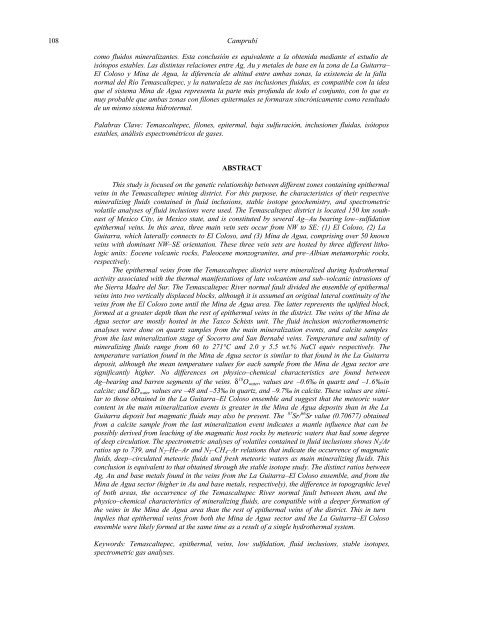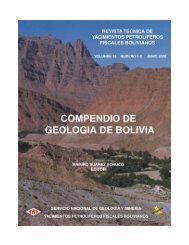geoquím fluidos epiterm_Mexico
You also want an ePaper? Increase the reach of your titles
YUMPU automatically turns print PDFs into web optimized ePapers that Google loves.
108<br />
Camprubí<br />
como <strong>fluidos</strong> mineralizantes. Esta conclusión es equivalente a la obtenida mediante el estudio de<br />
isótopos estables. Las distintas relaciones entre Ag, Au y metales de base en la zona de La Guitarra–<br />
El Coloso y Mina de Agua, la diferencia de altitud entre ambas zonas, la existencia de la falla<br />
normal del Río Temascaltepec, y la naturaleza de sus inclusiones fluidas, es compatible con la idea<br />
que el sistema Mina de Agua representa la parte más profunda de todo el conjunto, con lo que es<br />
muy probable que ambas zonas con filones <strong>epiterm</strong>ales se formaran sincrónicamente como resultado<br />
de un mismo sistema hidrotermal.<br />
Palabras Clave: Temascaltepec, filones, <strong>epiterm</strong>al, baja sulfuración, inclusiones fluidas, isótopos<br />
estables, análisis espectrométricos de gases.<br />
ABSTRACT<br />
This study is focused on the genetic relationship between different zones containing epithermal<br />
veins in the Temascaltepec mining district. For this purpose, the characteristics of their respective<br />
mineralizing fluids contained in fluid inclusions, stable isotope geochemistry, and spectrometric<br />
volatile analyses of fluid inclusions were used. The Temascaltepec district is located 150 km southeast<br />
of <strong>Mexico</strong> City, in <strong>Mexico</strong> state, and is constituted by several Ag–Au bearing low–sulfidation<br />
epithermal veins. In this area, three main vein sets occur from NW to SE: (1) El Coloso, (2) La<br />
Guitarra, which laterally connects to El Coloso, and (3) Mina de Agua, comprising over 50 known<br />
veins with dominant NW–SE orientation. These three vein sets are hosted by three different lithologic<br />
units: Eocene volcanic rocks, Paleocene monzogranites, and pre–Albian metamorphic rocks,<br />
respectively.<br />
The epithermal veins from the Temascaltepec district were mineralized during hydrothermal<br />
activity associated with the thermal manifestations of late volcanism and sub–volcanic intrusions of<br />
the Sierra Madre del Sur. The Temascaltepec River normal fault divided the ensemble of epithermal<br />
veins into two vertically displaced blocks, although it is assumed an original lateral continuity of the<br />
veins from the El Coloso zone until the Mina de Agua area. The latter represents the uplifted block,<br />
formed at a greater depth than the rest of epithermal veins in the district. The veins of the Mina de<br />
Agua sector are mostly hosted in the Taxco Schists unit. The fluid inclusion microthermometric<br />
analyses were done on quartz samples from the main mineralization events, and calcite samples<br />
from the last mineralization stage of Socorro and San Bernabé veins. Temperature and salinity of<br />
mineralizing fluids range from 60 to 271°C and 2.0 y 5.5 wt.% NaCl equiv respectively. The<br />
temperature variation found in the Mina de Agua sector is similar to that found in the La Guitarra<br />
deposit, although the mean temperature values for each sample from the Mina de Agua sector are<br />
significantly higher. No differences on physico–chemical characteristics are found between<br />
Ag–bearing and barren segments of the veins. δ 18 O water , values are –0.6‰ in quartz and –1.6‰ in<br />
calcite; and δD water values are –48 and –53‰ in quartz, and –9.7‰ in calcite. These values are similar<br />
to those obtained in the La Guitarra–El Coloso ensemble and suggest that the meteoric water<br />
content in the main mineralization events is greater in the Mina de Agua deposits than in the La<br />
Guitarra deposit but magmatic fluids may also be present. The 87 Sr/ 86 Sr value (0.70677) obtained<br />
from a calcite sample from the last mineralization event indicates a mantle influence that can be<br />
possibly derived from leaching of the magmatic host rocks by meteoric waters that had some degree<br />
of deep circulation. The spectrometric analyses of volatiles contained in fluid inclusions shows N 2 /Ar<br />
ratios up to 739, and N 2 –He–Ar and N 2 –CH 4 –Ar relations that indicate the occurrence of magmatic<br />
fluids, deep–circulated meteoric fluids and fresh meteoric waters as main mineralizing fluids. This<br />
conclusion is equivalent to that obtained through the stable isotope study. The distinct ratios between<br />
Ag, Au and base metals found in the veins from the La Guitarra–El Coloso ensemble, and from the<br />
Mina de Agua sector (higher in Au and base metals, respectively), the difference in topographic level<br />
of both areas, the occurrence of the Temascaltepec River normal fault between them, and the<br />
physico–chemical characteristics of mineralizing fluids, are compatible with a deeper formation of<br />
the veins in the Mina de Agua area than the rest of epithermal veins of the district. This in turn<br />
implies that epithermal veins from both the Mina de Agua sector and the La Guitarra–El Coloso<br />
ensemble were likely formed at the same time as a result of a single hydrothermal system.<br />
Keywords: Temascaltepec, epithermal, veins, low sulfidation, fluid inclusions, stable isotopes,<br />
spectrometric gas analyses.
















